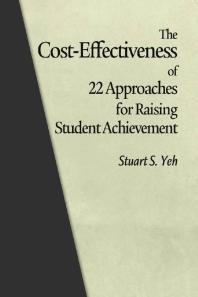The Cost Effectiveness of 22 Approaches for Raising Student Achievement 1st Edition by Stuart S Yeh ISBN 1617354023 978-1617354021
$50.00 Original price was: $50.00.$35.00Current price is: $35.00.
The Cost Effectiveness of 22 Approaches for Raising Student Achievement 1st Edition by Stuart S Yeh2 – Ebook PDF Instant Download/Delivery: 1617354023 , 978-1617354021
Full download The Cost Effectiveness of 22 Approaches for Raising Student Achievement 1st edition after payment

Product details:
ISBN 10: 1617354023
ISBN 13: 978-1617354021
Author: Stuart S Yeh
As a consequence of the federal “No Child Left Behind” (NCLB) law, there is tremendous pressure on school principals, teachers, school superintendents, district staff, state departments of education and governors to maximize the increase in student achievement that is obtained with every dollar of expenditure. Currently, teachers are forced to rely on extremely inefficient approaches that take enormous amounts of time, both during the school day and throughout the K-12 learning years. This is experienced in terms of the reduced time that is available to teach subjects other than math and reading, as schools resort to double periods of math, double periods of reading, and enormous amounts of remedial instruction that directly reduce the time available for other subjects including science, art, and music. In contrast, this book suggests that student achievement may be increased in a way that is not only cost-effective in dollar terms, but efficient in the sense that it does not rely on unusual investments in the time required to obtain results. The book draws upon a wealth of cost-effectiveness data to dispel common notions about “what works” in addressing the achievement gap: increased expenditure per pupil, charter schools, voucher programs, increased educational accountability, class size reduction, comprehensive school reform, increased teacher salaries, more selective teacher recruitment, the use of “value-added” methods to measure and reward teacher performance, the use of National Board teacher certification to identify high-performing teachers, and a host of other approaches.
The Cost Effectiveness of 22 Approaches for Raising Student Achievement 1st Table of contents:
-
Introduction: The Importance of Cost-Effective Strategies in Education
- Overview of Student Achievement and Educational Goals
- The Need for Cost-Effective Solutions in Education
-
Criteria for Evaluating Cost-Effectiveness
- Defining Cost-Effectiveness in Educational Settings
- Methods for Measuring Costs and Outcomes
- Factors Affecting Educational Effectiveness
-
Approach 1: Improving Teacher Quality
- Teacher Training and Professional Development
- Cost vs. Impact Analysis of Teacher Quality Improvement
-
Approach 2: Reducing Class Size
- The Evidence on Class Size and Student Achievement
- Cost-Benefit Considerations for Smaller Classes
-
Approach 3: After-School Programs
- Effectiveness of Extended Learning Hours
- Financial Implications of After-School Initiatives
-
Approach 4: Early Childhood Education
- Benefits of Early Learning Programs
- Evaluating Long-Term Impact and Costs
-
Approach 5: Parental Involvement
- Strategies for Engaging Parents in Education
- Cost-Effectiveness of Parental Engagement Programs
-
Approach 6: Academic Support for At-Risk Students
- Targeted Interventions for Struggling Learners
- Cost Analysis of Support Services for At-Risk Students
-
Approach 7: Summer School Programs
- Benefits and Costs of Summer Learning Opportunities
- Effectiveness in Preventing Summer Learning Loss
-
Approach 8: Technology Integration in the Classroom
- Impact of Digital Tools on Student Learning
- Assessing the Cost-Effectiveness of Technology in Education
-
Approach 9: Curriculum Reform
- Curriculum Overhaul and Alignment with Student Needs
- Economic Analysis of Curriculum Changes
-
Approach 10: Peer Tutoring and Mentoring
- The Benefits of Peer Support in Education
- Financial Implications of Peer Tutoring Programs
-
Approach 11: Teacher Collaboration and Team Teaching
- Collaborative Teaching Models and Student Achievement
- Cost-Effectiveness of Team Teaching Approaches
-
Approach 12: School Choice and Charter Schools
- Exploring the Impact of School Choice on Student Outcomes
- Costs and Benefits of Expanding Charter Schools
-
Approach 13: Implementing Standardized Testing
- The Role of Testing in Monitoring Achievement
- Financial and Educational Costs of Standardized Assessments
-
Approach 14: Alternative Learning Environments
- Non-Traditional School Models and Their Effectiveness
- Cost-Benefit Analysis of Alternative Education Programs
-
Approach 15: Mentorship and Counseling Programs
- The Role of Mentorship in Student Success
- Costs of Implementing Counseling Services
-
Approach 16: Improving School Leadership
- Leadership Development and Its Impact on Student Performance
- Financial Assessment of School Leadership Training
-
Approach 17: School Safety Programs
- The Relationship Between School Safety and Student Achievement
- Evaluating the Financial Costs of Safety Initiatives
-
Approach 18: Health and Nutrition Programs
- The Impact of Student Health on Academic Performance
- Cost-Effectiveness of School-Based Health Interventions
-
Approach 19: School Infrastructure and Environment
- The Physical Environment’s Role in Student Learning
- Financial Analysis of School Infrastructure Improvements
-
Approach 20: Social-Emotional Learning (SEL) Programs
- The Benefits of SEL on Student Achievement
- Cost Considerations for SEL Implementation
-
Approach 21: School-Community Partnerships
- Strengthening Community Ties for Student Success
- Analyzing the Financial Effectiveness of Partnerships
-
Approach 22: Teacher Autonomy and Innovation
- Encouraging Teacher Innovation in the Classroom
- Financial and Educational Outcomes of Teacher Empowerment
-
Conclusion: A Comprehensive Analysis of Cost-Effective Approaches
- Summary of Findings
- Recommendations for Policymakers and Educators
People also search for The Cost Effectiveness of 22 Approaches for Raising Student Achievement 1st:
cost-effective strategies
the cost approach is most effective
cost-effectiveness evaluation
cost-effectiveness model
a cost-effectiveness analysis focuses on a program’s
Tags:
Stuart S Yeh,The Cost,Raising Student



